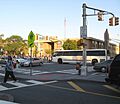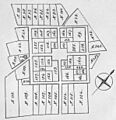Bergen Square facts for kids
Bergen Square is a really old and important place in Jersey City. You can find it where Bergen Avenue and Academy Street meet, in the bigger Journal Square area. It's a busy spot with homes and shops. You'll see all sorts of buildings here, from old 1800s houses to modern Art Deco styles. What's super cool is that it's home to the longest continuously used school site in the United States!
Close by, you can visit the Van Wagenen House (sometimes called the Apple Tree House) and the Old Bergen Church. Both of these buildings are from the time when America was still a group of colonies. Also, the St. George & St. Shenouda Coptic Orthodox Church was one of the first Coptic churches in New Jersey, started by early Egyptian families who moved here.
Contents
A Look Back: The History of Bergen Square
How Bergen Started
Bergen Square and the streets around it are where the very first town in New Jersey began! This town, called Bergen, was set up in 1660 by the Dutch in a place they called New Netherland. Later, in 1683, it became Bergen Township.
The main leader of New Netherland, Petrus Stuyvesant, gave permission for people to settle here. There's even a statue of him, the Peter Stuyvesant Monument, in the square, put there in 1913 to remember this event. A person named Jacques Cortelyou planned out the square. It was one of the first places in the United States to use a special layout that later became known as a "Philadelphia square."
Even though no buildings from that very early time are still standing, you can still see the original street plan. Many street names, like Vroom, Van Reypen, and Newkirk, remind us of the first Dutch village. Nearby, you'll find old cemeteries and the Old Bergen Church, which were also started by those early settlers and their families.
Early Challenges and Growth
Before Bergen was officially founded, there were some earlier European settlements nearby, like Pavonia. But these places faced tough times. There were conflicts between the Dutch settlers and the Lenape, who were the Native Americans living there. During a conflict called Kieft's War, settlers had to leave their homes and go to the safer New Amsterdam (which is now Manhattan).
After a peace agreement in 1645, the settlements at Pavonia and Communipaw started to grow again. But then, in 1655, another conflict called the Peach War caused more trouble.
A New Plan for Safety
Because of these conflicts, settlers wanted more safety. So, in 1658, Petrus Stuyvesant made a deal with the Lenape people. This deal was for a much larger area called Bergen. It stretched from a big rock near Wiehacken all the way down to Bayonne.
A key part of this deal was that a fort or garrison had to be built. This way, farmers living on their land around the village could quickly go to a safe place if there was an attack. The village also got its own special government. This made Bergen the main center for all the European settlements on the west side of the Hudson River.
Changing Hands: From Dutch to English
In 1664, the English took control of New Netherland from the Dutch. On September 22, 1668, the English officially recognized Bergen's original town rules.
Then, in 1674, after the English fully owned New Netherland, the village of Bergen became part of a special type of colony called East Jersey. It became the "capital" of one of the new areas, Bergen County. Bergen remained the main government center until 1710, when the government moved to Hackensack.
Images for kids
-
Front of the Old Bergen Church in 1938





